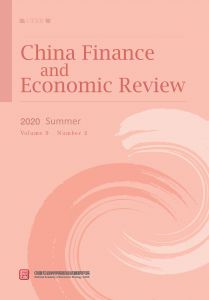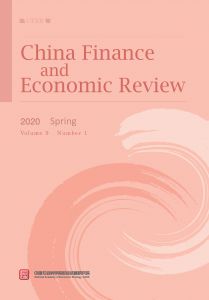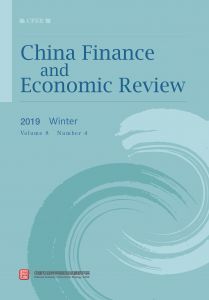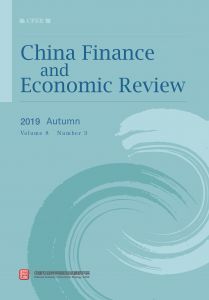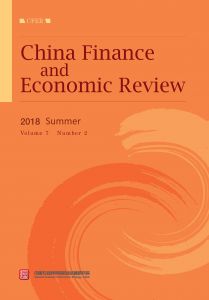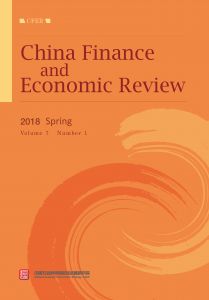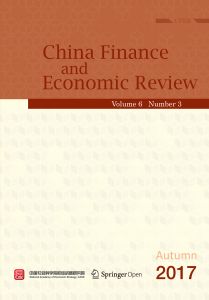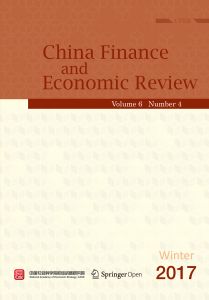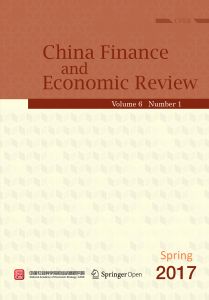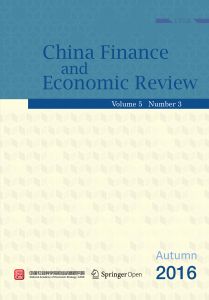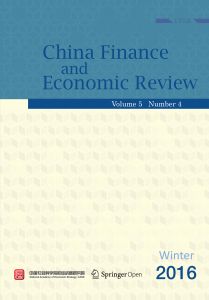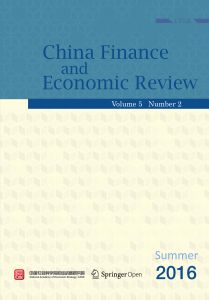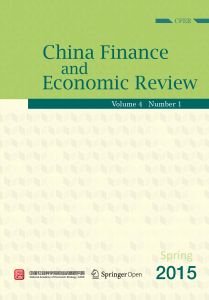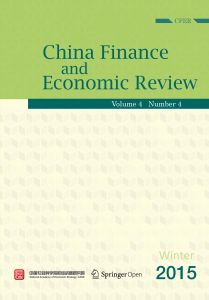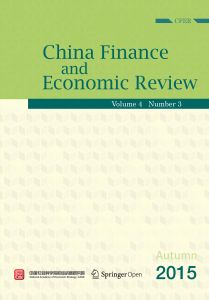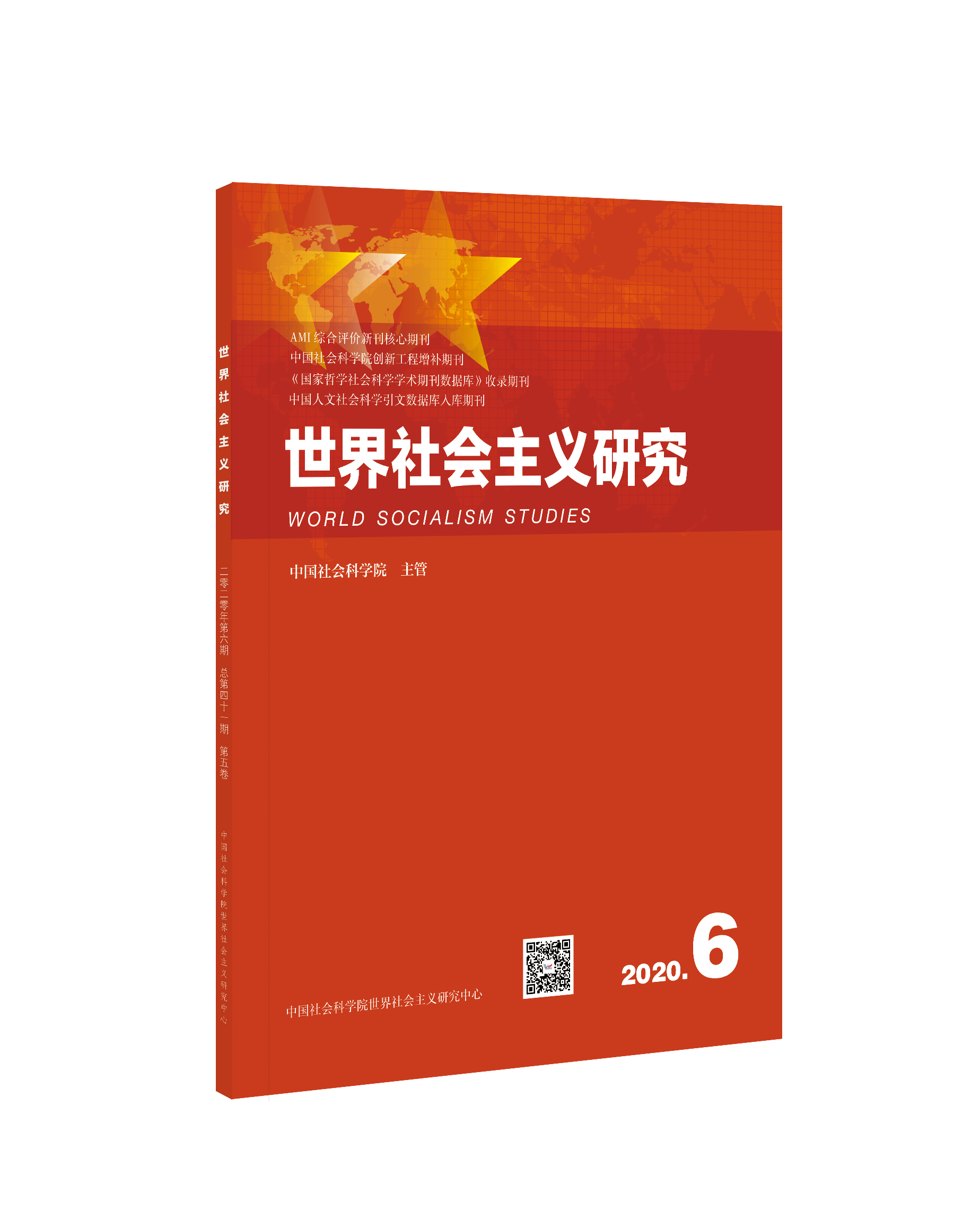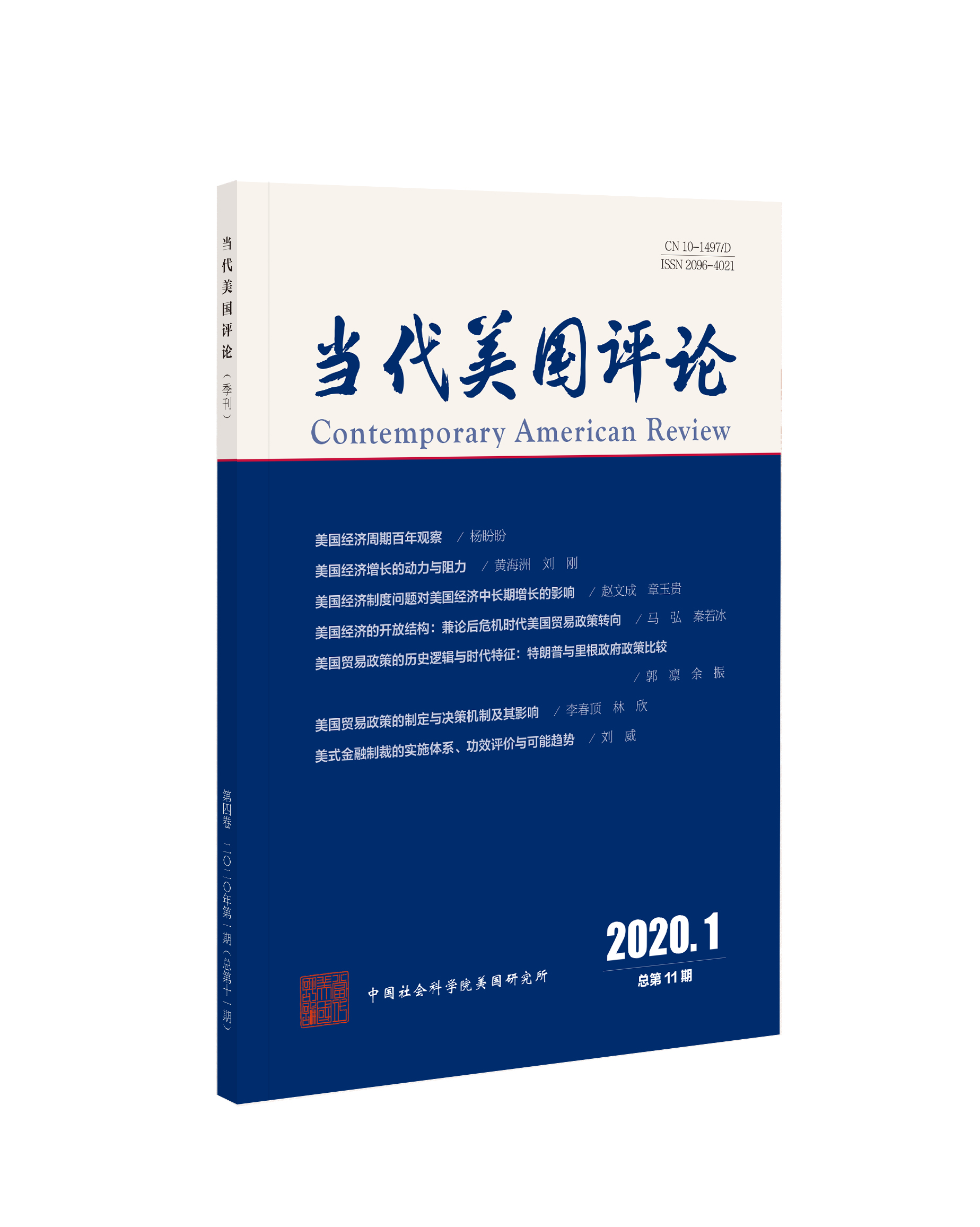最新期刊
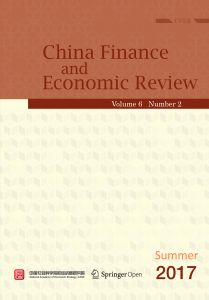
目录
过往期刊
参考文献
-
Instructions for Authors
-
编委会
-
Whether profitability and investment factors have additional explanatory power compared with Fama-French three-factor model: Empirical evidence on Chinese A-share stock market
-
1. Introduction
-
2. Special features of Chinese stock market
-
3. Data and methodology
-
4. Empirical results
-
5. Fama-French five-factor model on U.S. stock market
-
6. Discussion
-
7. Conclusions
-
-
Impact of market access and comparative advantage on regional distribution of manufacturing sector
-
1. Introduction
-
2. Theoretical model
-
3. Empirical settings and data
-
4. Conclusions
-
-
A study on the dynamic comparison of logistics industry’s correlation effects in China
-
1. Introduction
-
2. Methods and analyses
-
3. Results and discussion
-
4. Conclusions
-
-
Impacts of financial decentralization on economic growth and inflation in China
-
1. Introduction
-
2. Financial decentralization and theoretical analysis
-
3. Research design and data specification
-
4. Empirical research of financial decentralization
-
5. Conclusions
-
-
Transfer payment structure and local government fiscal efficiency: The quantile regression by panel data
-
1. Introduction and literature review
-
2. The measurement of financial efficiency
-
3. The theoretical analysis of transfer payment structure affecting fiscal efficiency
-
4. Empirical test
-
5. Conclusions and policy implications
-
-
An analysis of property income of households in China
-
1. Introduction
-
2. Comparison of proportion and structure of household income among China, USA and Japan
-
3. Analysis of causes for low property income in China
-
4. Results and conclusions
-
按年份浏览:
- 全部
- 2020
- 2019
- 2018
- 2017
- 2016
- 2015
- 2014
- 2013
[1][1]Ahlgren, N., Sjö, B., & Zhang, J. (2009). Panel cointegration of Chinese A and B shares. Applied Financial Economics , 19 (23), 1859-1871.
[2][2]Carhart, M. M. (1997). On persistence in mutual fund performance. The Journal of Finance , 52 (1), 57-82.
[3][3]Chen, C., Hu, X., Shao, Y., & Wang, J. (2015). Fama-French in China: Size and value factors in Chinese stock returns. University of Hong Kong Working Paper.
[4][4]Chen, G.-M., Lee, B.-S., & Rui, O. (2001). Foreign ownership restrictions and market segmentation in China’s stock markets. Journal of Financial Research, 24 (1), 133-155.
[5][5]Chen, Z. (2004). Cross-sectional variations and three factors asset pricing model: Empirical evidences from China A share market. Chinese Journal of Management Science, 12(6), 12-17.
[6][6]Chiah, M., Chai, D., & Zhong, A. (2015). A better model? An empirical investigation of the Fama-French five-factor model in Australia. In 2015 Financial Markets & Corporate Governance Conference.
[7][7]Cohen, R. B., Gompers, P. A., & Vuolteenaho, T. (2002). Who underreacts to cash-flow news? Evidence from trading between individuals and institutions. Journal of Financial Economics , 66 (2-3), 409-462.
[8][8]Drew, M. E., Naughton, T., & Veeraraghavan, M. (2003). Firm size, book-to-market equity and security returns: Evidence from the Shanghai Stock Exchange. Australian Journal of Management , 28 (2), 119-139.
[9][9]Eun, C. S., & Huang, W. (2007). Asset pricing in China’s domestic stock markets: Is there a logic? Pacific-Basin Finance Journal , 15 (5), 452-480.
[10][10]Fairfield, P. M., Whisenant, J.S., & Yohn, T. L. (2003). Accrued earnings and growth: Implications for future profitability and market mispricing. The Accounting Review , 78 (1), 353-371.
[11][11]Fama, E. F., & French, K. R. (1993). Common risk factors in the returns on stocks and bonds. Journal of Financial Economics , 33 (1), 3-56.
[12][12]Fama, E. F., & French, K. R. (2006). Profitability, investment and average returns. Journal of Financial Economics , 82 (3), 491-518.
[13][13]Fama, E. F., & French, K. R. (2014). A five-factor asset pricing model, Fama-Miller Working Paper (September).
[14][14]Fama, E. F., & French, K. R. (2015). International tests of a five-factor asset pricing model. Fama-Miller Working Paper.
[15][15]Fernald, J., & Rogers, J. H. (2002). Puzzles in the Chinese stock market. Review of Economics and Statistics , 84 (3), 416-432.
[16][16]Fung, H.-G., Lee, W., & Leung, W. K. (2000). Segmentation of the A-and B-share Chinese equity markets. Journal of Financial Research, 23 (2), 179-195.
[17][17]Gibbons, M. R., Ross, S. A., & Shanken, J. (1989). A test of the efficiency of a given portfolio. Econometrica , 57 (5) 1121-1152.
[18][18]Haugen, R. A., & Baker, N. L. (1996). Commonality in the determinants of expected stock returns. Journal of Financial Economics , 41 (3), 401-439.
[19][19]Hou, K., Xue, C., & Zhang, L. (2015). Digesting anomalies: An investment approach. Review of Financial Studies , 28 (3), 650-705.
[20][20]Hung, C.-H. D., Chen, Q., & Fang, V. (2015). Non-tradable share reform, liquidity, and stock returns in China. International Review of Finance , 15 (1), 27-54.
[21][21]Martinsa, C. C., & Eid, Jr, W. (2015). Pricing assets with Fama and French 5-factor model: A Brazilian market novelty. In XV Encontro Brasileiro de Finanças.
[22][22]Novy-Marx, R. (2013). The other side of value: The gross profitability premium. Journal of Financial Economics , 108 (1), 1-28.
[23][23]Richardson, S. A., & Sloan, R. G. (2003). External financing and future stock returns. Rodney L. White Center for Financial Research Working Paper.
[24][24]Sun, Q., & Tong, W. H. (2000). The effect of market segmentation on stock prices: The China syndrome. Journal of Banking & Finance , 24 (12), 1875-1902.
[25][25]Titman, S., Wei, K.J., & Xie, F. (2004). Capital investments and stock returns. Journal of Financial and Quantitative Analysis , 39 (4), 677-700.
[26][26]Wang, Y., & Di Iorio, A. (2007). The cross section of expected stock returns in the Chinese A-share market. Global Finance Journal , 17 (3), 335-349.
[27][27]Zhang, S., & Xu, J. (2013). The Fama-French three factors in the Chinese stock market. Ssrn Electronic Journal , 16 (2), 210-227.
[28][28]Artz, G. M., Kim, Y., & Orazem, P. F. (2015). Does agglomeration matter everywhere?: New firm location decisions in rural and urban markets. Journal of Regional Science , 56 (1), 72-95.
[29][29]Audretsch, D. B., & Feldman, M. P. (2004). Chapter 61 knowledge spillovers and the geography of innovation. Handbook of Regional and Urban Economics , 4 (4), 2713-2739.
[30][30]Baldwin, R. E. (2003). Economic geography and public policy . Princeton, NJ: Princeton University Press.
[31][31]Bania, N., Calkins, L. N., & Dalenberg, D. R. (1992). The effects of regional science and technology policy on the geographic distribution of industrial R&D laboratories. Journal of Regional Science , 32 (2), 209-228.
[32][32]Bania, N., Eberts, R. W., & Fogarty, M. S. (1993). Universities and the startup of new companies: Can we generalize from Route 128 and Silicon Valley? Review of Economics & Statistics , 75 (4), 761-766.
[33][33]Baptista, R., & Swann, P. (1998). Do firms in clusters innovate more? Research Policy , 27 (5), 525-540.
[34][34]Behrens, K., Lamorgese, A. R., Ottaviano, G. I., & Tabuchi, T. (2009). Beyond the home market effect: Market size and specialization in a multi-country world. Journal of International Economics , 79 (2), 259-265.
[35][35]Behrens, K., & Thisse, J. (2007). Regional economics: A new economic geography perspective. Regional Science and Urban Economics , 37 (4), 457-465.
[36][36]Chiambaretto, P., De Palma, A., & Proost, S. (2013). A normative analysis of transport policies in a footloose capital model with interregional and intraregional transportation costs. The Annals of Regional Science , 51 (3), 811-831.
[37][37]Chow, G. C. (1993). Capital formation and economic growth in China. The Quarterly Journal of Economics , 108 (3), 809-842.
[38][38]Chow, G. C. (2010). Interpreting China’s economy . World Scientific, doi: 10.1142/9789814317962.
[39][39]Ciccone, A. (2002). Agglomeration effects in Europe. European Economic Review , 46 (2), 213-227.
[40][40]Davis, D. R., & Weinstein, D. E. (2003). Market access, economic geography and comparative advantage: An empirical test. Journal of International Economics , 59 (1), 1-23.
[41][41]Depret, M., & Hamdouch, A. (2013). Clusters, networks, and entrepreneurship. Encyclopedia of Creativity, Invention, Innovation and Entrepreneurship , 211-224.
[42][42]Delgado, M., Porter, M. E., & Stern, S. (2010). Clusters and Entrepreneurship. Journal of Economic Geography , 10 (4), 495-518.
[43][43]Dixit, A., & Stiglitz, J. (1977). Monopolistic competition and optimum product diversity. American Economic Review , 67 (3), 297-308.
[44][44]Ellison, G., Glaeser, E. L., & Kerr, W. R. (2010). What causes industry agglomeration? Evidence from coagglomeration patterns. American Economic Review , 100 (3), 1195-1213.
[45][45]Feldman, M. P. (1999). The new economics of innovation, spillovers and agglomeration: A review of empirical studies. Economics of Innovation & New Technology , 8 (1-2), 5-25.
[46][46]Florax, R., & Folmer, H. (1992). Knowledge impacts of universities on industry an aggregate simultaneous investment model. Journal of Regional Science , 32 (4), 437-466.
[47][47]Fujita, M., Krugman, P. R., & Venables, A. (1999). The spatial economy: Cities, regions and international trade . Cambridge, MA: MIT Press.
[48][48]Garau, G., & Lecca, P. (2013). The impact of regional R&D subsidy in a computable general equilibrium model. International Regional Science Review , 38 (4), 319-357.
[49][49]Ghosh, M. (2007). R&D policies and endogenous growth: A dynamic general equilibrium analysis of the case for Canada. Review of Development Economics , 11 (1), 187-203.
[50][50]Glasson, J. (2001). The widening local and regional development impacts of the modern universities—A tale of two cities (and North-South perspectives). Local Economy , 18 (18), 21-37.
[51][51]Hanson, R. C., & Song, M. H. (1998). Shareholder wealth effects of free trade: U.S. and Mexican stock market response to NAFTA. International Review of Economics & Finance , 7 (2), 209-224.
[52][52]Head, K., Mayer, T., & Ries, J. (2002). On the pervasiveness of home market effects. Economica , 69 (275), 371-390.
[53][53]Jofre-Monseny, J., Marín-López, R., & Viladecans-Marsal, E. (2011). The mechanisms of agglomeration: Evidence from the effect of inter-industry relations on the location of new firms. Journal of Urban Economics , 70 (2-3), 61-74.
[54][54]Kang, C., Zhou, T., Chen, Q., Xu, Q., Xia, Q., & Ji, Z. (2012). Carbon emission flow in networks. Scientific Reports , 2 (2). 479.
[55][55]Krugman, P. (1991). Increasing returns and economic geography. Journal of Political Economy , 99 (3), 483-499.
[56][56]Li, D., Lu, Y., & Wu, M. (2012). Industrial agglomeration and firm size: Evidence from China. Regional Science and Urban Economics , 42 (1-2), 135-143.
[57][57]MacPherson, A., & Krugman, P. (1992). Geography and trade. Economic Geography , 68(2), 216.
[58][58]Marshall, A., (1890). Principles of economics . ed. MacMillan.
[59][59]Martin, P. (1995). Industrial location and public infrastructure. Journal of International Economics , 39(3-4), 335-351.
[60][60]Martin, P. (1999). Public policies, regional inequalities and growth. Journal of Public Economics , 73 (1), 85-105.
[61][61]Martin, P., & Rogers, C. A. (1995). Industrial location and public infrastructure. Journal of International Economics , 39 (3-4), 335-351.
[62][62]McCann, P., & Shefer, D. (2004). Location, agglomeration and infrastructure. Fifty Years of Regional Science , Part of the series Advances in Spatial Science , 177-196.
[63][63]Pavitt, K. (1998). Technologies, products and organization in the innovating firm: What Adam Smith tells us and Joseph Schumpeter doesn’t. Industrial and Corporate Change , 7 (3), 433-452.
[64][64]Pekkala, S. (2002). Migration and individual earnings in Finland: A regional perspective. Regional Studies , 36 (1), 13-24.
[65][65]Saxenian, A. L. (1994). Regional advantage: Culture and competition in Silicon Valley and Route 128 . Cambridge, MA: Harvard University Press.
[66][66]Sivitanidou, R., & Sivitanides, P. (1995). The intrametropolitan distribution of R&D activities: Theory and empirical evidence. Journal of Regional Science , 35 (3), 391-416.
[67][67]Thursby, M., Thursby, J., & Gupta-Mukherjee, S. (2007). Are there real effects of licensing on academic research? A life cycle view. Journal of Economic Behavior & Organization , 63 (4), 577-598.
[68][68]Verspagen, B. (1999). European ‘regional clubs’: Do they exist, and where are they heading? On economic and technological differences between European regions. Economic Growth and Change , doi:10.4337/9781840647617.00019.
[69][69]Zhang, X., & Zhang, K. H. (2003). How does globalisation affect regional inequality within a developing country? Evidence from China. Journal of Development Studies , 39 (4), 47-67.
[70][70]Cao, Y. (2007). Industrial relevancy analysis on regional logistics. Urban Studies , 1, 143-146.
[71][71]Chen, X. F. (2006). The industrial correlation and involvement of China’s logistics industry . Guangdong Jinan University, Dissertation, 21-27.
[72][72]China Federations of Logistics and Purchase. (2013). Report of China’s logistics’ development 2012-2013 . China Goods and Materials Press.
[73][73]Coto-Millán, P., Agüeros, M., Casares-Hontañón, P., & Pesquera, M. Á. (2013). Impact of logistics performance on world economic growth (2007-2012). World Review of Intermodal Transportation Research , 4 (4), 300-310.
[74][74]Leontief, W. (1990). Economics of input and output . China Statistics Press.
[75][75]Liang, H. G., & Wang, J. (2013). The research into the industrial correlation between logistics industry and manufacturing industry — Comparative analysis basing on input-output tables. Journal of Fujian Normal University (Philosophy and Social Sciences Edition) , 2, 71-72.
[76][76]Liu, D., & Wang, J. (2011). Strategy for the development of logistics industry in Fujian Province based on input-output analysis. China Business and Market , 11, 49-52.
[77][77]Liu, Y. (2014). The compilation and analysis of input-output “industry-by-industry” table of China . Shanxi University of Finance and Economics, Dissertation, 23-25.
[78][78]Research group of China input-output society. (2002). Analysis into industrial correlation in current China-one of the analysis reports on the input and output for 2002. Statistical Research , 11, 3-8.
[79][79]Shao, Y., Liang, L., & Zhang, Y. S. (2009). Analysis on the relational degree between logistics industry on input-output theory and other industries. Journal of Changchun University of Science and Technology (Social Science Edition) , 22 (3), 395-397.
[80][80]Sheng, Y. (2012). An analysis on the economic effects of China’s logistics industry and its changes. Journal of Industrial Technological Economics , 10, 129-135.
[81][81]Song, Z., & Chang, D. L. (2008). A Study on spread effect of logistics industry in China. Journal of Business Economics , 195 (1), 3-9.
[82][82]Sun, J. S., & Huang, L. (2009). Empirical studies on logistics industries and economic growth. Journal of Industrial Technological Economics , 28 (1), 53-59.
[83][83]Wang, H. Y. (2007). An analysis on logistics in China based on input-output theory . Liaoning Dalian Maritime University, Dissertation, 23-26.
[84][84]Wei, M. X., Wang, L., & Li, Y. (2009). The industrial association and spreading effects resulting from modern logistics industry. Journal of Business Economics , 218 (12), 15-21.
[85][85]Akai, N., & Sakata, M. (2002). Fiscal decentralization contributes to economic growth: Evidence from state-level cross-section data for the United States. Journal of Urban Economics , 52 (1), 93-108.
[86][86]Ba, S., Liu, X., & Niu, B. (2005). Interaction between local governance and bank reform in China’s financial system during transition period. Journal of Financial Research (Jinrong Yanjiu) , 5, 25-37.
[87][87]Blanchard, O., & Shleifer, A. (2000). Federalism with and without political centralization: China versus Russia. NBER Working Papers, No.7616.
[88][88]Brandt, L., & Zhu, X. (2001). Soft budget constraint and inflation cycles: A positive model of the macro-dynamics in China during Transition. Journal of Development Economic , 64 (2), 437-457.
[89][89]Chen, S., & Gao, l. (2002). The Relationship between Central and local governments: Reappraisal of measurement and mechanism of fiscal decentralization. Management World (Guanli Shijie) , 6, 43-59.
[90][90]Fraschini, A. (2006). Fiscal federalism in big developing countries: China and India. Institute of Public Policy and Public Choice Working paper, No.66.
[91][91]Fu, Y. (2008). What’s the difference of China’s decentralization: An analysis framework considering fiscal and political incentives. The Journal of World Economy (Shijie Jingji) , 11 , 16-25.
[92][92]Fu, Y. (2010). Fiscal decentralization, governance and non-economic public goods provision. Economic Research Journal (Jingji Yanjiu) , 8, 4-15.
[93][93]Fu, Y., & Zhang, Y. (2007). China’s decentralization and expenditure structure bias: The price of competition for growth. Management World (Guanli Shijie) , 3, 4-12.
[94][94]Guo, F. (2014). Endogenous terms and comparison effect of establishing local financial institutions. Quarterly Journal of Finance (Jinrongxue Jikan) , 8 (2), 36-56.
[95][95]He, D., & Miao, W. (2016). Does the fiscal decentralization impact the financial decentralization? Economic Research Journal (Jingji Yanjiu) , 2, 42-55.
[96][96]Ji, Z., Zhou, L., Wang, P., & Zhao, Y. (2014). Promotion incentives of local officials and bank lending: Evidence from China’s city commercial banks. Journal of Financial Research (Jinrong Yanjiu) , 1, 1-15.
[97][97]Jin, H., Qian, Y., & Weingast, B. R. (2005). Regional decentralization and fiscal incentives: Federalism Chinese style. Journal of Public Economics , 89 (9-10), 2005, 1719-1742.
[98][98]Kiefer, D. (2008). Inflation target, the nature rate and expectations. University of Utah Department of Economics Working Paper, No.2008-03.
[99][99]Li, W., & Qian, X. (2012). Local official governance and credit supply of the city commercial banks. China Economic Quarterly (Jingjixue Jikan) , 11 (4), 1239-1260.
[100][100]Lin, J. Y., & Liu, Z. (2000). Fiscal decentralization and economic growth in China. Economic Development and Cultural Change , 49 (1), 1-22.
[101][101]Martinez-Vazquez, J., & Mcnab, R. M. (2003). Fiscal decentralization and economic growth. World Development , 31 (9), 1597-1616.
[102][102]Montinola, G., Qian, Y., & Weingast, B. R. (1995). Federalism, Chinese style: The political basis for economic success in China. World Politics , 48 (1), 50-81.
[103][103]Qian, Y., & Roland, G. (1998). Federalism and the soft budget constraint. American Economic Review , 88(5), 1143-1162.
[104][104]Shen, K., & Fu, W. (2005). The relationship between China’s decentralized system in finance and her regional economic growth. Management World (Guanli Shijie) , 1, 31-39.
[105][105]Tan, Z., & Zhou, L. (2015). Officials’ Tenure, Credit Cycles and Investment Cycles. Journal of Financial Research (Jinrong Yanjiu) , 6, 80-93.
[106][106]Zhang, Y., & Gong, L. (2005). The Fenshuizi reform, fiscal decentralization, and economic growth in China. China Economic Quarterly (Jingjixue Jikan) , 5 (1), 75-108.
[107][107]Zhao, W., & Zhou, Y. (2009). Research on the relationship between fiscal expenditure and inflation based on provincial panel data. Economic Research Journal (Jingji Yanjiu) , 10, 48-60.
[108][108]Zhou, L. (2003). The second fiscal and financial division of China’s financial industry during the reform. The Journal of World Economy (Shijie Jingji) , 6, 72-79.
[109][109]Zhou, L. (2004). The incentive and cooperation of government officials in the political tournaments: An interpretation of the prolonged local protectionism and duplicative investments in China. Economic Research Journal (Jingji Yanjiu) , 6, 33-40.
[110][110]Zhou, Y., & Zhang, Q. (2008). Financial decentralization, economic growth and fluctuations. Management World (Guanli Shijie) , 3, 6-15.
[111][111]Afonso, A., & Aubyn, M. S. (2005). Cross-country efficiency of secondary education provision: A semi-parametric analysis with non-discretionary inputs. European Central Bank Working Paper, No.494.
[112][112]Afonso, A., & Fernandes, S. (2005). Assessing and explaining the relative efficiency of local government. The Journal of Sacio-Economics , 37 (5), 1946-1979.
[113][113]Albouy, D. (2010). Evaluating the efficiency and equity of federal fiscal equalization. Journal of Public Economics , 96 (9), 824-839.
[114][114]An T. F., & Ren, Q. (2008). Construction of equalization index of public service level—A quantitative analysis based on regional difference. Finance & Trade Economics (Caimao jingji) , 6 , 79-82.
[115][115]An, T. F. (2007). China’s transfer payment: Status, problems and reform suggestions. Public Finance Research (Caizheng Yanjiu) , 1, 2-5.
[116][116]Andersen, P., & Peteren, N. C. (1993). A procedure for ranking efficient units in data envelopment analysis. Management Science , 39 (10), 1261-1264.
[117][117]Athanassopoulos, A. D., & Triantis, K. P. (1998). Assessing aggregate cost efficiency and the related policy implications for Greek local municipalities. INFOR , 36 (3), 66-83.
[118][118]Baker, M. A., Payne, A., & Smart, M. (1999). An empirical study of matching grants: The ‘gap on CPA’. Journal of Public Economics, 72 (2), 269-288.
[119][119]Bhatt, A., & Scaramozzino, P. (2013). Federal transfers and fiscal discipline in India: An empirical evaluation. Asian Development Bank Economics Research Paper Series, Working Paper, 343.
[120][120]Borck, R., & Owings, S., The Political Economy of Intergovernmental Grants, Regional Science and Urban Economics, Vol.33, No.2, 2003, pp.139-156.
[121][121]Borger, B. D., & Kerstens, K. (1996). Cost efficiency of belgian local governments: A comparative analysis of FDH, DEA, and econometric approaches. Regional Science and Urban Economics , 26 (2), 145-170.
[122][122]Bradford, D. F., & Oates, W. E. (1971). Towards a predictive theory of intergovernmental grants. American Economics Reviews , 62 (2), 440-448.
[123][123]Brennan, G., & Pincus, J. (1996). A minimalist model of federal grants and flypaper effects. Journal of Public Economics , 61 (2), 229-246.
[124][124]Chen S. Y. & Zhang J. (2008). Study on the financial efficiency of local government: 1978-2005. Social Sciences in China (Zhongguo Shehui Kexue) , 4, 65-78.
[125][125]Davis, M. L., & Hayes, K. (1993). The demand for good government. The Review of Economics and Statistics , 75 (1), 148-152.
[126][126]Fan, Z. Y., & Zhang, J. (2010). How China sacrificed the efficiency in the balance: From the perspective of transfer payment. World Economy (Shijie Jingji) , 11, 117-138.
[127][127]Gamkhar, S., & Shah, A. (2007). The impact of intergovernmental fiscal transfers: A synthesis of the conceptual and empirical literature, in Boadway, R., & Shah, A. (eds.), Intergovernmental Fiscal Transfers: Principles and Practice . World Bank Publications, 225-258.
[128][128]Grossman, P., Mavros, P., & Wassmer, R. W. (1999). Public sector technical inefficiency in large U.S. cities. Journal of Urban Economics 46 (2), 278-299.
[129][129]Guo, Q. W., Jia, J. X., & Gao, L. (2009). Transfer payment of central finance and regional economic growth. World Economy (Shijie Jingji) , 12, 15-26.
[130][130]Hamilton, B. W. (1983). The flypaper effect and other anomalies, Journal of Public Economics , 22 (3), 347-361.
[131][131]Hayes, K. J., Razzolini, L., & Ross, L. B. (1998). Bureaucratic choice and nonoptimal provision of public goods: Theory and evidence. Public Choice , 94 (1-2), 1-20.
[132][132]Hines, J. R., & Thaler, R. H. (1995). Anomalies: The flypaper effect. Journal of Economic Perspectives , 9 (4), 217-226.
[133][133]Jia, J. X., Guo, Q. W., & Gao, L. (2010). Central government transfer payment, competition between incentive effect and regional financial expenditure. Finance & Trade Economics (Caimao Jingji) , 11, 52-57.
[134][134]Jia, X. J. (2009). Intergovernmental horizontal equilibrium effect of transfer payment. Economic Perspectives (Jingjixue Dongtai) , 3, 72-76.
[135][135]Koenker, R., & Bassett, G. J. (1978). Regression quantiles, Econometrica , 46 (1), 33-50.
[136][136]Koenker, R. (2004). Quantile regression for longitudinal data. Journal of Multivariate Analysis , 91 (1), 74-89.
[137][137]Li, Z. N., & Ye, A. Z. (2012). Advanced applied econometrics , Press of Tsinghua University (in Chinese).
[138][138]Liu, R. C., & Jiao, G. H. (2002). Difference in regional finance and innovation in transfer payment system. Finance & Trade Economics (Caimao Jingji) , 6, 5-12.
[139][139]Loikkanen, H. A., & Susiluoto, I. (2006). Cost efficiency of Finnish municipalities in basic service provision 1994-2002. Discussion Paper, No.96.
[140][140]Ma, S. Y., & Yu, H. X. (2003). Transfer payment and regional economic convergence. Economic Research Journal (Jingji Yanjiu) , 3, 26-33.
[141][141]Oates, W. E. (1994). Federalism & government finance. in Quigley, J. M., & Smolensky, E. (eds.), Modern Public Finance , Massachusetts: Harvard University Press, 126-164.
[142][142]Ping, X. Q. & Bai, J. (2006). The fiscal decentralization of China and supply of local public goods, Finance & Trade Economics (Caimao Jingji) , 2, 49-56.
[143][143]Qiao, B. Y., & Fan, J. Y., Peng J. M. (2006). Intergovernmental transfer payment and efforts of local finance. Management World (Guanli Shijie) , 3, 50-56.
[144][144]Seiford, L. M., & Zhu, J. (1998). Sensitivity analysis of DEA models for simultaneous changes in all the data. Journal of the Operational Research Society , 49 (10), 1060-1071.
[145][145]Tang, Q. M., & Wang, B. (2012). An empirical study on the efficiency of fiscal expenditure and the influencing factors in China. Journal of Financial Research (Jingrong Yanjiu) , 12, 48-61.
[146][146]Wilde, J. A. (1968). The expenditure effects of grant-in-aid programs. National Tax Journal , 21 (3), 340-348.
[147][147]Yin, H., Kang, L. L., & Wang, L. J. (2007). The effect of fiscal equalization of intergovernmental transfer payment. Management World (Guanli Shijie) , 1, 48-55.
[148][148]Zhu, L. (1997). Efficiency and fairness of transfer payment. Management World (Guanli Shijie) , 3, 30-35.
[149][149]Bai, C. E., & Qian, Z. J. (2009). Who has eroded residents incomes? An analysis of China’s national income distribution patterns, Social Sciences in China (Zhongguo Shehui kexue ), 5, 99-115.
[150][150]Chang, X. H., & Li, W. (2009). Calculating results of national income distribution patterns and its adjustment strategies. Macroeconomics (Hongguan Jingji Yanjiu) , 9, 20-25.
[151][151]European Commission, International Monetary Fund, Organization for Economic Cooperation and Development, United Nations & World Bank. (2008). System of National Accounts (SNA) .
[152][152]Fang, F. Q. (2009). A study of inadequate consumer demand among Chinese residents-based on data for urban and rural areas in different provinces. Social Sciences in China (Zhongguo Shehui Kexue) , 2, 68-82.
[153][153]Fang, W. Q. (2011). Empirical research on decisive factors of Chinese labor income share: structure adjustment or fiscal effects. Journal of Financial Research (Jinrong Yanjiu) , 2, 32-41.
[154][154]Guo, Q. W., & Lv, B. Y. (2011). The influence of tax on factor income distribution. Economic Research Journal (Jingji Yanjiu) , 6, 16-30.
[155][155]Jia, K., & Liu, W. (2010). Thoughts and suggestions on curbing in widening income gap of fiscal tax of two shares to improve national income distribution. Public Finance Research (Caizheng Yanjiu) , 12, 2-18.
[156][156]Li, W. P., & Li, J. (2011). Distribution of Factor Relative Price, capital Over-Deepening and Decline in labor Share, Academic Monthly (Xueshu Yuekan) , 02 , 68-77.
[157][157]Li, W. P., & Gong, M. (2010). Extensive growth of export labor-intensive oriented and structure imbalance of national income. Economic Perspectives (Jingjixue Dongtai) , 7, 57-61.
[158][158]Li, W. P., & Gong, M. (2013). Distortion of factor price ratio and sluggish consumption of residents. Theoretical Front in Higher Education (Gaoxiao Lilun Zhanxian) , 1, 63-69.
[159][159]Li, W. P., & Li, H. (2015). The loss of households’ investment repay under the interest rate regulation. Jilin University Journal Social Sciences Edition (Jilin Daxue Shehui Kexue Xuebao) , 6, 5-16.
[160][160]Lv, B. Y., & Yu, K. (2009). Trend of Chinese tax burden and changes on Chinese national income distribution patterns. Finance & Trade Economics (Caimao Jingji) , 3, 72-77.
[161][161]Peng, S., & Ye, X. D. (2008). On evolution of Chinese national income distribution pattern since 1978. Economic Review (Jingji Pinglun) , 2, 73-80.
[162][162]Ruan, J., & Ruan, J. K. (2011). The status quo, causes and countermeasures of income distribution. Economic Perspectives (Jingjixue Dongtai) , 2, 59-62.
[163][163]Wang, C. Z. (1995). Income distribution of residents in China . China Plan Publishing House (in Chinese).
[164][164]Wang, X. L. (2010). The current situation, problems and countermeasures of national income distribution in China. Journal of Chinese Academy of Governance (Guojia Xingzheng Xueyuan Xuebao) , 3, 23-27.
[165][165]Xu, X. C. (2014). Accurately understand the income distribution accounting. Economic Perspectives (Jingjixue Dongtai) , 3, 65-71.
[166][166]Zhou, M. H., Xiao, W., & Yao, X. G. (2010). China’s unbalanced economic growth and national income distribution. China Industrial Economics (Zhongguo Gongye Jingji) , 6, 35-45.
[展开]
相关推荐
手机可扫码阅读


